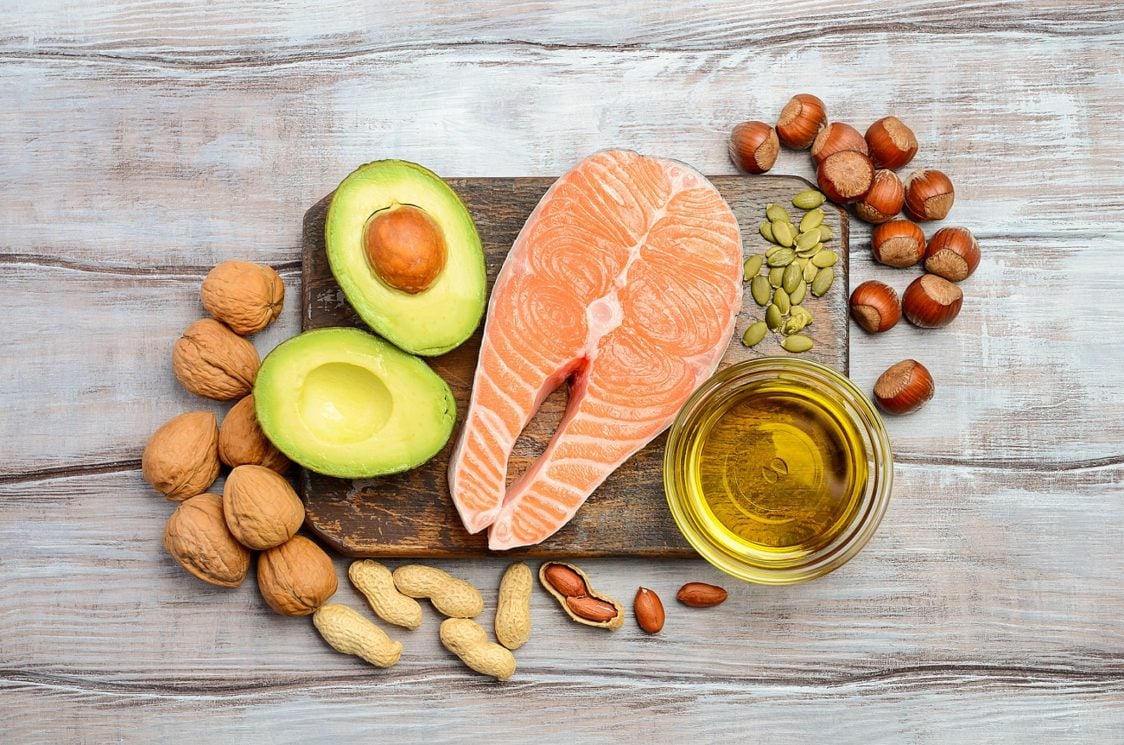Table of Contents
Gone are the days when fats as a whole were considered harmful to your health, low-fat diets were in vogue and almost everyone preferred to avoid fats in their diet. This view of fats has changed dramatically. Fortunately, nowadays we know that there are some fats that our body cannot make on its own.
To be healthy, it should be included in your diet without fail. We are talking, of course, about omega-3 and omega-6 fatty acids. However, in order for this not to be so simple, you need to meet a minimum intake and a certain ratio for optimal function of your body. However, most of you are miles away from that… Then what is the right ratio and amount?
What are omega-3 and omega-6 fatty acids?
Omega-3 and omega-6 fatty acids are two essential fats in your diet, namely polyunsaturated fatty acids (PUFAs), which are chemically characterised by having two or more double bonds specifically located in their structure. Your body’s cells cannot create this special fatty acid structure on their own. For this reason, you need to include them in your diet, which is why we speak of so-called essential fatty acids.
- Omega-6 fatty acids include linoleic and arachidonic acids.
- Omega-3 fatty acids include the so-called healthy fats in the form of alpha-linolenic acid and the better known eicosapentaenoic acid (EPA) and docosahexaenoic acid (DHA).
If you want to learn more about the overall breakdown of fats and their sources, you shouldn’t miss our article Healthy and Unhealthy Fats: Which Foods to Eat and Which to Avoid?

Why our body needs omega-3 and omega-6, and what is their function?
Omega-3 and omega-6 fatty acids are a common component of your body’s cell membranes, contributing to their normal function. In addition, your bodies make specialised molecules called prostaglandins, which are essential in regulating important bodily functions. [1]
The most discussed roles of prostaglandins in the body:
- proper immune function
- regulate inflammation
- blood clotting
- contribute to vascular function and blood pressure control
- regulation of body fat
- Simply put, omega-6 fatty acids produce substances that are more pro-inflammatory, they activate the immune system, increase blood clotting and cause vasoconstriction (constriction of the blood vessels, which slightly increases blood pressure).
- In contrast, omega-3 fatty acids produce substances with the opposite effect, reducing inflammation, suppressing immunity and counteracting blood clotting. They even form vasodilating substances that lower blood pressure.
Please don’t get us wrong, you clearly need both types of fatty acids and you should definitely not take away from this information that omega-6s are harmful only and omega-3s are solely beneficial to your health. As you may have guessed, their overall effect on your body is determined not only by their ratio to each other, but also by their overall intake.

Is there such a thing as an optimal ratio of omega-3 and omega-6 in one’s diet?
At first glance, this makes sense – if the ratio between omega-6 and omega-3 intake is skewed in favour of omega-6, the body will be overwhelmed by pro-inflammatory molecules and therefore be more susceptible to cardiovascular disease and other diseases of civilisation. This is supported by the fact that the ratio of omega-3 to omega-6 intake has really changed over the last fifty years or so. [1]

Throughout history, until recently, people have had a dietary ratio of 1-4:1 in favour of omega-3 fatty acids, whereas today it can easily be as high as around 30:1 or even higher! [1]
In order to understand some more complex phenomena, one naturally tends to simplify them, which may, however, leave out some key facts. This is probably also the case with the issue of the ratio of omega-3 to omega-6 in the diet.
What do some professional societies say about the ratio of the two types of fat in the diet?
- According to the Czech Society for Nutrition, the ratio between omega-6 and omega-3 intake should not exceed 5:1. [2]
- However, if you consider the latest dietary recommendations for fats from the World Health Organization (WHO), rather than a given ratio, there is a recommendation for the intake of omega-6 and omega-3 fatty acids as a percentage of total energy intake. [3]
Recommended intake for omega-3 and omega-6 fatty acids:
- Omega-6 fatty acids should make up 2.5-9% of your total energy intake.
- Omega-3 fatty acids should make up 0.5-2% of your total energy intake.
- If one wanted to calculate a ratio from these numbers, the ratios could range from a “near perfect” 1.25:1 to a “horrific” 18:1 ratio in favour of omega sixes.
Not all omega-3 fattty acids are the same…
However, when you look at specific types of omega-3 fatty acids and their effect on the production of anti-inflammatory molecules, not all of them have equal “value” to the body. In fact, eicosapentaenoic acid (EPA) and docosahexaenoic acid (DHA) are much easier for the body to make than alpha-linolenic acid (ALA).
In order for ALA to be involved in this production, it must be painstakingly converted in the body first from EPA to the key acid DHA. However, this conversion is very low, around 1%. [4]
This is why you simply cannot lump all omega-3s together, you must look at their total intake as a whole, and compare them to the total intake of omega-6s, as each omega-3 has a different potential to produce anti-inflammatory molecules.
You might be interested in these products:
Thus, rather than an “ideal ratio”, you need to focus on a sufficient intake of EPA and DHA
People often see claims that they are consuming omega-6 fatty acids in excess in the diet, skewing the ratio heavily in favour of the pro-inflammatory omega-6 linoleic acid. What is the reality?
First of all, well-conducted human studies have never proven that higher intakes of linoleic acid increase the production of pro-inflammatory substances. [5]
And secondly. According to one of the largest studies of its kind, how does the average Central European, either Czech or Slovak, actually measure up in terms of their intake of omega-6 and omega-3 fatty acids? [6]
- Omega-6 intake is between 8-9% of total energy intake, which is within the WHO recommended range (2.5-9%).
- We even meet the intake of plant-based omega-3 alpha-linolenic acid (above 0.5%, i.e. 1.1g is the intake in the Czech Republic and Slovakia is about 1.3 g per day).
- However, the WHO recommendation that we are critically failing to meet is the recommendation on the intake of omega-3 fatty acids EPA and DHA. The Czech population with about 150 mg of EPA+DHA per day and the Slovaks with less than 60 mg are well below the recommended intake of 250-500 mg per day. Other Central Europeans will not be much better off.
It is this factor of EPA+DHA intake that is likely to play a much larger role than the overall ratio of omega-3 to omega-6 without information on which omega-3s (EPA+DHA vs. ALA) are specifically addressed in the diet. [7]

In what foods can you find plant ALA and the most valuable EPA and DHA?
The plant-based omega three alpha-linolenic acid (ALA) also has value, although it is not as beneficial to the body as EPA and DHA.
- Sources of fats containing significant amounts of ALA include flaxseed oil, flax and chia seeds, canola oil and walnuts.
- EPA and DHA are found in oily marine fish that have fed on a diet in cold marine waters (algae and shellfish naturally containing these fatty acids) during their lifetime. Farmed fish with a different diet may have a much lower or zero EPA and DHA content.
- Of course, EPA and DHA intake can also be covered by dietary supplements in the form of fish oil or special vegan omega 3s made from the seaweed genus Schizochytrium, which also contain EPA and DHA.
If you want to learn more about sources of fat, you shouldn’t miss our article Omega-3 Fatty Acids: Are You Consuming Enough of Them and in the Right Ratio to Omega-6?

How to achieve an optimal intake of EPA and DHA?
How can you achieve an optimal intake of EPA and DHA omega-3 fatty acids, which is most often in the range of 250-500 mg for a healthy adult? Basically, you have two options.
- The first is to eat fatty marine fish (salmon, mackerel, herring, trout) about two times a week.
- If you are not a keen eater of fish, you can get by just fine with a fish oil supplement. Depending on the EPA and DHA content, which can vary between different fish oils, this works out to approximately 250-500 mg of EPA+DHA in 1-2 capsules.
How do I know that my intake ratio of fats, including omega-3s, is in check?
Nowadays, it is possible to do a home blood test, which will show you from just a few drops of your blood what fatty acids are present in the membranes of your cells.
With these tests you can obtain information about:
- the specific percentages of each fatty acid group,
- their relative proportions (including omega-3:omega-6),
- the proportion of harmful trans-unsaturated fatty acids
- or the so-called HS-index (Omega-3 index).
The HS-index reveals the representation of omega-3 fatty acids in the cell membranes of red blood cells. An HS-index value in the range of 8-11% is associated with a significantly lower risk of cardiovascular disease. Therefore, it may be a much more valuable indicator of omega-3 and omega-6 fatty acid intake than the outdated and somewhat misleading ratio of omega-3 to 6 in the diet. [8, 9]

What can you take away from this for your own use?
According to current research, the intake of omega-3 and omega-6 fatty acids has a significant impact on your health. Therefore, let’s try to summarise the most important findings of the article into a few tips for a healthier fat intake overall and for improving your ratio and total intake of omega-3 and omega-6 fatty acids.
- The problem with a typical Western European diet is not so much an excess of omega-6 fatty acids, as it may seem at first glance and is often mentioned, but rather a deficiency of the most valuable omega-3 fatty acids EPA and DHA. Therefore, pay attention to the intake of these. For a healthy adult, 250-500 mg of EPA+DHA per day should be sufficient through daily consumption of marine fish (salmon, mackerel, herring, trout) or a dietary supplement (fish oil, algae oil or krill oil).
- A plant-based omega-3 alpha-linolenic acid is also useful, although its conversion to EPA and DHA is very low. Therefore, increase your consumption of foods with a higher content – flaxseed oil, flax and chia seeds, canola oil and walnuts.
- You certainly don’t have to worry about consuming omega-6 fatty acids (linoleic acid) through high-quality plant sources in their natural form (vegetable oils, nuts). These are necessary for your body. However, do not overdo it, because you can ingest it to a certain extent in meat or cereals, but to a greater extent in processed foods (confectionery, long-life foods and sweet baked goods, etc.).
Rather than laboriously calculating the ratio of omega-3 and omega-6 fatty acid intake in your diet, which doesn’t always tell the whole truth anyway, check your blood levels of omega-3 (HS-index) and other fatty acids with a blood test (e.g. a diagnostic test). And in the case of any unfavourable values, adjust your diet accordingly.
[1] SIMOPOULOS A. – An Increase in the Omega-6/Omega-3 Fatty Acid Ratio Increases the Risk for Obesity. – https://www.ncbi.nlm.nih.gov/pmc/articles/PMC4808858/.
[2] SPOLEČNOST PRO VÝŽIVU – Výživová doporučení pro obyvatelstvo České republiky. – https://www.vyzivaspol.cz/vyzivova-doporuceni-pro-obyvatelstvo-ceske-republiky/
[3] WHO – Fats and fatty acids in human nutrition. Report of an expert consultation. – https://pubmed.ncbi.nlm.nih.gov/21812367/
[4] BRENNA T. – Alpha-Linolenic acid supplementation and conversion to n-3 long-chain polyunsaturated fatty acids in humans. – https://pubmed.ncbi.nlm.nih.gov/19269799/
[5] JOHNSON G. – Effect of Dietary Linoleic Acid on Markers of Inflammation in Healthy Persons: A Systematic Review of Randomized Controlled Trials.– https://pubmed.ncbi.nlm.nih.gov/22889633/.
[6] MICHA – Global, regional, and national consumption levels of dietary fats and oils in 1990 and 2010: a systematic analysis including 266 country-specific nutrition surveys.– https://pubmed.ncbi.nlm.nih.gov/24736206/.
[7] ANDERSON B. – Are all n-3 polyunsaturated fatty acids created equal? – https://www.ncbi.nlm.nih.gov/pmc/articles/PMC3224740/
[8] SCHACKY C. – Omega-3 Index and Cardiovascular Health. – https://www.ncbi.nlm.nih.gov/pmc/articles/PMC3942733/
[9] HARRIS W. – The Omega-6:Omega-3 ratio: A critical appraisal and possible successor – https://pubmed.ncbi.nlm.nih.gov/29599053/


Add a comment